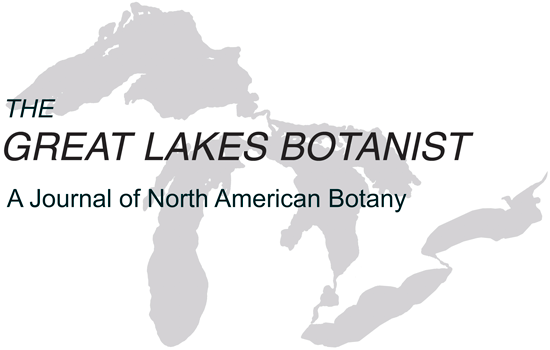Garrett Crow and Dave Warners continue their series of studies of the Grand Rapids area flora inspired by the pioneering work of Emma Cole’s 1901 Grand Rapids Flora. This is the sixth entry in the series, several of which have included student authors in important roles. It is also the second article in the series that reports on botanical assessments of parcels in the Lowell Regional Greenspace, which is under development as park and recreational areas by Kent County Parks. The first of the two articles assessed high-quality woodland parcels in the Greenspace, while this article assesses high-quality shrub-carr and hardwood swamp wetlands.
It is not often that species new to science are discovered in the Great Lakes region. The second article in this issue is the second report of a new species of goldenrod (Solidago) from Michigan to be published in the pages of this journal. The first was the description of Solidago vossii Pringle & Laureto (Voss’s Goldenrod) in 2010. Now, Jess Peirson, who has been studying the coastal dune goldenrods in Michigan for some time, describes a new species from the dunes along the southern shore of Lake Superior in Michigan’s Upper Peninsula. In addition to a thorough description of the new species and its habitat and an account of its relationships with near relatives, the article also includes notes on other endemic taxa of Solidago in the Great Lakes region and an updated key to all species of Solidago in Michigan. For this purpose, the species sometimes segregated into the genus Oligoneuron are retained in Solidago.
Harvey Ballard, an authority on the genus Viola, reports the second occurrence of Viola epipsila (Dwarf Marsh Violet) in the eastern United States. Expanding on the usual format for Noteworthy Collections articles, the author provides a detailed and informative discussion of the taxonomic relationships of this species and its relatives.
This issue concludes with reviews of two recent books, Wildflowers of the Indiana Dunes National Park, published earlier this year, and Botany for the Artist. The Indiana Dunes National Park, located on the southern shore of Lake Michigan and which was upgraded from a National Lakeshore just a couple of years ago, is one of the floristically richest units in the National Park system as well as in the Great Lakes area. This new wildflower guide provides for the first time a thorough guide to the commonly encountered species of the Park and should also be useful throughout the greater Chicago area. Botany for the Artist instructs the reader not only in drawing techniques but in the necessary visual aspects of botanical structure, thereby assisting the artist in seeing the object of the art in a special way.
